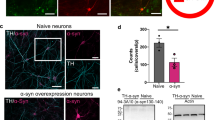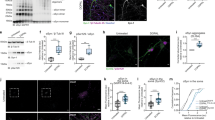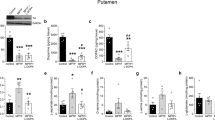Abstract
THE observations that the normally high concentration of dopamine in the substantia nigra is reduced in Parkinsonism1, that reserpine, which depletes catecholamines, can produce a Parkinsonian syndrome2 and that both anticholinergic drugs and L-dopa partially relieve the symptoms of the disease3,4, have led to the implication of an imbalance between dopaminergic and cholinergic activity in Parkinsonism. Our recent results, however, support previous reports that, apart from a neuro-transmitter deficiency, a dysfunction of protein synthesis might be involved. According to this hypothesis, an unknown agent interferes with the normal function of the glial genome. It stimulates the synthesis of new messenger RNA (mRNA) which specifies proteins for growth and division. The normal inverse metabolic coupling between neurone and glia is disturbed during proliferation, and as a result similar changes to those in the proliferating glia may occur in the neurone, leading to its biochemical and functional de-differentiation. The neurone may no longer be capable of synthesizing certain functional proteins, including those needed for neurotransmitter synthesis, transport and storage. As a result, though not degenerate, it would fail to act as a signalling device. Our data in support of this hypothesis are (a) that reserpine, which induces a Parkinsonism-like syndrome in man2, induces increased synthesis of DNA, RNA and proteins in animals, and intense glial proliferation5; (b) that an increase in RNA, inversely related to melanin content, occurs in the nigral neurones of Parkinsonian patients who died during the early stages of the disease (M. I., submitted for publication); (c) that an abnormal electrophoretic pattern of blood cell proteins was found in Parkinsonian patients (H. Pataryas and C. N. S., manuscript in preparation).
This is a preview of subscription content, access via your institution
Access options
Subscribe to this journal
Receive 51 print issues and online access
$199.00 per year
only $3.90 per issue
Buy this article
- Purchase on Springer Link
- Instant access to full article PDF
Prices may be subject to local taxes which are calculated during checkout
Similar content being viewed by others
References
Hornykiewicz, O., Wien. Klin. Wschr., 75, 309 (1963).
Steck, H., Ann. Méd. Psychol., 112, 737 (1954).
Birkmayer, W., and Hornykiewicz, O., Wien. Klin. Wschr., 73, 787 (1961).
Cotzias, G., Papavasiliou, P. S., and Gallene, R., New England J. Med., 280, 337 (1969).
Mytilineou, C., Biological Psychiat., 1, 61 (1969).
Friede, R., Arch. Exp. Path. Pharmakol., 218, 286 (1953).
Forrest, F. M., Forrest, I. S., and Roizin, L., Agressologie, 4, 259 (1963).
Gomirato, G., and Haydén, H., Brain, 86, 773 (1963).
Whittaker, J. R., J. Exp. Zool., 169, 143 (1968).
McCarl, R. L., and Shaler, R. C., J. Cell Biol., 40, 850 (1969).
Davidson, R., Ephrussi, B., and Yamamoto, K., J. Cell Physiol., 72, 115 (1968).
Weisberger, A. S., and Wolfe, S., Fed. Proc., 23, 976 (1964).
Firkin, F. C., and Linnane, A. W., Exp. Cell Res., 55, 68 (1969).
Rubin, A. L., and Stenzel, K. H., Neurosciences Res. Prog. Bull., 3, 25 (1965).
Hydén, H., in The Neuron (edit. by Hydén, H.), 179 (Elsevier, Amsterdam,1967).
Seale, R. U., and Prasad, K. N., Anat. Rec., 163, 259 (1969).
Author information
Authors and Affiliations
Rights and permissions
About this article
Cite this article
STEFANIS, C., ISSIDORIDES, M. Aberrant mRNA in Parkinsonism: Support for Hypothesis from Studies with Chloramphenicol. Nature 225, 962–963 (1970). https://doi.org/10.1038/225962a0
Received:
Issue Date:
DOI: https://doi.org/10.1038/225962a0
This article is cited by
Comments
By submitting a comment you agree to abide by our Terms and Community Guidelines. If you find something abusive or that does not comply with our terms or guidelines please flag it as inappropriate.



